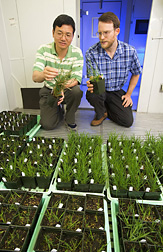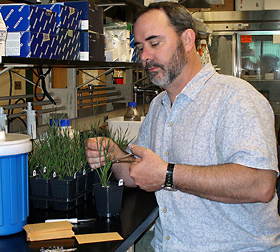Brachypodium
A Little-Known Grass Gains Research Fame
|
|
David Garvin may be the first U.S. scientist to pursue research using a wild grass known as “purple false brome,” Brachypodium distachyon, as a model plant.
Garvin, a plant geneticist with the ARS Plant Science Research Unit in St. Paul, Minnesota, learned of the short-statured plant’s possibilities from researchers working in Europe. Early in 2002, he started his own investigations to explore its potential to serve as a model, or surrogate, for its close relatives—including wheat, rye, and barley.
Unlike these familiar crops, Brachypodium has a small genome—about one-fiftieth that of wheat, for instance.
Garvin’s goal—then and now—is to use Brachypodium to speed discovery of genes that will improve wheat’s resistance to diseases such as rusts, Fusarium head blight, and others that can cause dramatic yield losses.
“Since Brachypodium is closely related to wheat, barley, and other small grains,” Garvin says, “pinpointing genes for important traits such as disease resistance in Brachypodium should help us quickly find those same genes in these major crops. We expect their functions and relative locations on Brachypodium and wheat chromosomes to be about the same.”
Garvin’s work attracted the attention of plant molecular biologist John Vogel at the ARS Western Regional Research Center in Albany, California, near San Francisco. Vogel saw the value of using this new model plant to improve energy crops such as switchgrass—a Brachypodium cousin.
|
|
Vogel’s intent: To discover how to more quickly and inexpensively break down the plant cell walls that make cellulosic ethanol costly to produce.
With other ARS colleagues, Garvin and Vogel have made ARS a world leader in getting Brachypodium adopted as an international model for grass-crop research. Seeds of Brachypodium plants that Garvin developed specifically for research have been sent freely to scientists in 25 states and 20 nations. According to Garvin, these genetic stocks are now being used for innovative genetic, genomic, physiological, and molecular biological research for grass-crop improvement.
And, thanks to his lab and greenhouse experiments, some of these research-ready plants now have an impressive seed-to-seed turnaround time of less than 8 weeks.
One of Garvin’s genetic stocks, for example, was chosen for use in an international venture to sequence the Brachypodium genome. Based at the U.S. Department of Energy’s Joint Genome Institute in Walnut Creek, California, the project will reveal the structure of all the plant’s genes and other genetic material. Garvin, Vogel, and Michael Bevan of the John Innes Center in the United Kingdom are co-directors of this genome journey, which has already yielded a rough draft and is expected to produce an improved version sometime this year.
Brachypodium—Transformed!
In their California laboratories and greenhouses, Vogel, geneticist Yong Gu, and research leader Olin Anderson—all with the Genomics and Gene Discovery Research Unit—have used Garvin’s plants in groundbreaking experiments.
Vogel, for instance, was the first to report the successful shuttling of new genes into Brachypodium via a bacterium, Agrobacterium tumefaciens. This biotech approach offers more precision than another popular method—one that relies on a gene gun to blast genes into plant tissue.
A good model plant accepts, and activates, genes that scientists move into it. The process, called “transformation,” allows researchers to learn more about the genes—what they do inside the plant, and how they might be enhanced or perhaps silenced.
“An efficient transformation system is an absolute requirement for a model system,” says Vogel, who recently hit a transformation rate of about 60 percent. It’s among the highest reported for any grass.
For the most part, grasses remain very resistant to accepting genes that scientists—using techniques of modern biotechnology—would like to give them. “Grasses are notoriously difficult to transform,” says Vogel. That makes the hard-won transformation rate for Brachypodium even more noteworthy.
A Map Takes Shape
Garvin’s genetic stocks were just as essential to experiments that have yielded the first-ever physical map for Brachypodium. The map, developed by Yong Gu in collaboration with Ming-Cheng Luo at the University of California-Davis, depicts the location of neighboring, or contiguous, stretches of Brachypodium DNA.
The California team has pried yet more genetic secrets out of Garvin’s plants. The researchers analyzed a portion of the plants’ activated genetic material, or RNA, contained in bits of roots, stems, leaves, and other tissue snipped from seedling and fully grown Brachypodium. Their experiment identified indicators of active genes, or ESTs (short for expressed sequence tags). These ESTs act like signposts to guide scientists to genes that were actively working inside the tissue.
ESTs quicken the hunt for genes of interest. The Albany scientists identified more than 20,400 ESTs and posted them on the publicly available GenBank website, an encyclopedia of genomic information from the world’s plants, insects, worms, humans, and other forms of life.
“This was the first significant genomic resource for Brachypodium,” says Vogel. “Until then, GenBank had only nine Brachypodium ESTs.”
“Ready access to genetic and genomic research materials such as genetic stocks, maps, genes, and the genome sequence is required to make a stand-out model plant,” Garvin says. “We’re giving scientists worldwide that type of access. For the past 6 years, we’ve shared Brachypodium seeds, provided practical information and research data, and worked cooperatively with a large community of interested plant researchers here and abroad.
“All this has helped transform Brachypodium from a relative unknown to a worldwide favorite for grass-crop research.”—By Don Comis and Marcia Wood, Agricultural Research Service Information Staff.
This research is part of Plant Genetic Resources, Genomics, and Genetic Improvement (#301) and Bioenergy and Energy Alternatives (#307), two ARS national programs described on the World Wide Web at www.nps.ars.usda.gov.
David F. Garvin is with the USDA-ARS Plant Science Research Unit, 411 Borlaug Hall, 1991 Upper Buford Circle, St. Paul, MN 55108; phone (612) 625-1975, fax (651) 649-5058.
John P. Vogel, Yong Q. Gu, and Olin D. Anderson are with the USDA-ARS Western Regional Research Center, Genomics and Gene Discovery Research Unit, 800 Buchanan St., Albany, CA 94710; phone (510) 559-5934, fax (510) 559-5818.
"Brachypodium: A Little-Known Grass Gains Research Fame" was published in the September 2008 issue of Agricultural Research magazine.








